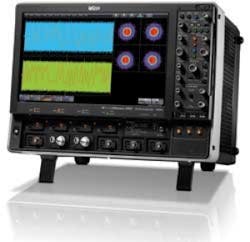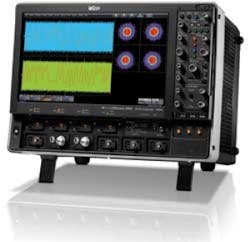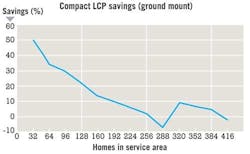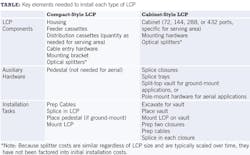By Mark Conner and Catherine McNaught
Compact local convergence points bring a new degree of economy to telco and cable MSO access architectures.
The local convergence point (LCP), in many respects, is the heart of the modern all-fiber access network (AFAN). It supports scaling of splitters, allows single-subscriber management, provides testing and troubleshooting access, and supports future technology migrations and updates.
So it is no wonder that so much thought has gone into refining this part of the network. Today's LCPs take their humble beginnings from outdoor cabinets capable of housing a variety of rack-mounted hardware. To become more space and cost efficient, specialized cabinets were developed to enable improved scaling of splitters and better routing of the splitter output fibers. However, like their rack-style predecessors, they were still large. This meant they took up real estate and created complaints about the "yard furniture" in the neighborhood.
The opportunity to innovate was clear. A couple of evolutionary steps later, third-generation cabinets were down to 40 percent of the size of the first-generation LCPs. They became much more pleasing to the eye and easier to install. Internal fiber management also improved. Splitter module "leg length" was cut in half, and yet-to-be-used splitter outputs were easily accommodated in "parking lots." The modern day LCP had arrived.
The LCP evolutionary process began around 2003 and had reached "Gen III" status by about 2006. As illustrated in Figure 1, feeder and distribution splicing remained external to the LCP throughout. Changes since then have been incremental, and the design has been fairly stable–until now.
The next turn
To understand the next turn requires a look at some of the challenges service providers face today, with a sprinkle of economic validation for good measure.
Many consumers can choose from multiple well-established providers offering triple-play services (voice, video, and data), and service providers are feeling the competitive pressure. A variety of telcos are considering ways to more efficiently access rural areas, while some MSOs are investigating the most cost-effective ways of deploying an AFAN in residential or business applications. For the MSO evaluating cost-effective AFAN options, maintaining the look and feel of a hybrid fiber/coax network, while achieving the simplicity of design, function, and low maintenance of fiber, is an easy way of realizing the cost savings AFANs make possible. For telcos, maintaining the functionality of the LCP in a smaller, scalable, and more efficient package would be just the ticket for seizing opportunity in less dense, rural, or slower take-rate areas.
Figure 2. Compact LCPs can be placed on aerial strands and in a low-profile pedestal without the need for external splice closures, vaults, or excavation.
The need for cost-effective new builds and overbuilds is perhaps more important in this economic environment than ever before. Additionally, the number of opportunities to take advantage of greenfield deployments in new home developments has significantly decreased in the past couple of years. Despite these challenges, the cost-conscious service provider still has many opportunities, which leads them to investigate ways to access customers that previously were cost-prohibitive.
It is important to note that there are differences between telco and MSO applications. Cable operators prefer to use fewer cabinets than telcos. The MSOs tend to put nodes and amplifiers in low-profile pedestals or on strands in aerial deployments, avoiding the pole whenever possible. Looking at where and how the network is deployed today is a good indication of how an MSO may choose to use an LCP.
A traditional telco design, on the other hand, has leveraged cabinets with 288 and 432 homes-passed (HP) capacities using a central-splitting architecture. This design is excellent at scaling the optical splitter used in the network, but usually requires excavation for a vault, as well as potentially pouring a concrete pad for cabinet mounting. Telco architectures also may require longer, higher count cables in the neighborhood. Holding the LCP size to 144 HP minimizes cable fiber counts and can eliminate the need for vaults and costly excavation.
Both environments would benefit from an LCP that is as easy to install as:
- Hanging a closure or node on a strand or setting it on a pedestal
- Connecting it so that "plug-and-play" connectivity for splitters and subscriber management is in place.
Next steps in LCP evolution?
LCPs are evolving to include smaller, more configurable devices or "compact LCPs." Several key elements set these compact LCPs apart from cabinet-style counterparts.
Reduced foot-print and costs: A smaller LCP can fit where cable operators place their network elements, such as nodes. Vaults and excavation needed for cabinet-style LCPs are not required for smaller LCPs, as they are versatile enough to be placed on strands, in vertical and low-profile pedestals, and on walls and poles. Strand mounting avoids the time and cost for permitting. Because the compact LCP effectively "segments" the capacity of a larger cabinet, it can be installed in phases, to match neighborhood development. As a result, the savings can be significant to the network operator accustomed to placing cabinet-style LCPs.
Figure 3. Relative cost savings for compact-style LCP compared to cabinet-style LCP.
Configurability: Internal configurability, using just cassettes, splitters, and entry/mounting hardware, means that any desired capacity (homes passed) or functionality can be quickly created in the field. This modular approach means splitters and even the addition of a new distribution cable can be scaled, allowing these costs to be deferred until the capability is needed.
Internal splicing: By bringing traditional stub cable splicing inside the LCP, extra components, such as splice closures, are not needed, reducing material and some handling costs. Furthermore, allowing cassettes to hold both splicing and connectivity removes the need for separate splice trays.
Universal application: Because of its modular design, the compact LCP can be configured for a variety of deployment scenarios (Figure 2):
- Central split; with all splitting in the compact LCP, up to 144 subscribers can be served
- Distributed split; placing 1x8 splits in the compact LCP and 1x4 in terminals serves up to 384 subscribers
- WDM; the LCP can serve as a central wavelength management point for business and node segmentation applications.
Does a compact LCP reduce costs?
Total installed cost, which accounts for LCP and auxiliary materials, as well as placement costs, is the best way to compare LCP options. Compact LCPs reduce costs by minimizing placement and auxiliary equipment costs. Auxiliary equipment includes external splice closures, vaults, and mounting hardware. A modeling scenario that compares a traditional cabinet-based LCP deployment to a smaller compact LCP will show how the smaller unit can benefit operators.
The model compares the two approaches by using typical costs for the auxiliary material and installation tasks, resulting in a total installed cost for a range of serving area sizes from 32 to 416 homes passed (see Table).
By calculating the total installed cost for various numbers of homes passed, the model reflects the fact that a single cabinet of appropriate size can serve any of these homes-passed values, while multiple compact LCPs would be deployed. Also considered is the fact that the cabinet-based LCP comes in larger capacity increments (288, 432, etc.) and requires a vault and external splice cases. On the other hand, the compact LCP can be configured in 12-fiber increments and requires only a pedestal for on-ground mounting. Aerial mounting of the cabinet requires appropriate pole-attachment hardware, whereas the compact LCP can mount directly to the strand.
The key modeling result, shown in Figure 3, assumes a ground-mounted (vault or pedestal) scenario and indicates significant savings for the compact LCP approach in serving areas up to 250 homes passed. An operator could use the compact LCP in smaller serving areas, low-density/rural deployments, and areas where aesthetic appeal or strand-mount convenience is important. The cabinet-based or compact LCP can be used for larger and/or higher density serving areas. Additional savings will be realized through reduced fiber counts surrounding the compact LCP.
Conclusion
Competitive pressure to offer bundled services and smaller new-build neighborhoods are driving the need for efficient deployment methods for the AFAN. Such challenges require creative approaches made possible with compact LCPs. Compact LCPs offer cost-saving opportunities and simple, flexible, low-cost installation options without compromising critical features, such as splitter scaling and subscriber management. Highly configurable LCPs enable the MSO or telco to address a range of geographies and architectures while minimizing total installed cost.
Mark Conner and Catherine McNaught are market development managers at Corning Cable Systems.




